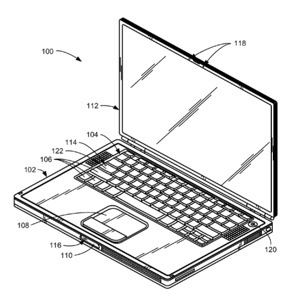Apple is working on a invisible, light-transmissive display system per a new patent (number 20110122560) that’s appeared at the US Patent & Trademark Office. The results could be things like light-transmissive, reconfigurable keyboards.
Per the patent, substantially invisible, tapered, light-transmissive holes are penetrated in a light-transmissive pattern through at least a portion of the light resistant material using a laser beam having a focal width less than the smallest diameter of the tapered holes. The inventors are Bartley K. Andre, Daniel J. Coster, Richard P. Howarth, Daniele de Iuliis, Jonathan P. Ive, Shin Nishibori, Matthew Dean Rohrbach, Douglas B. Satzger, Calvin Q. Seid, Christopher J. Stringer, Eugene Antony Whang, Rico Zorkendorfer, David Morgenstern and Paul C.L. Chow.
Here’s Apple’s background and summary of the invention: “The present invention relates generally to device display systems, and more particularly to invisible, light-transmissive display systems that become visible when illuminated from behind.
“In the world of consumer devices, and particularly consumer electronics, there is an ever-present demand for improved appearance, improved functionality, and improved aesthetics. Industrial design has become a highly skilled profession that focuses on fulfilling this need for enhanced consumer product appearance, functionality, and aesthetics.
“One area that continually receives great attention for improvement is user displays. Providing crisp, attractive, unambiguous, and intuitively friendly displays and information for the user is very important in many consumer products. However, as consumer products constantly become smaller and smaller, and in some cases more and more complex, it becomes increasingly difficult to present and display user information in a manner that is easy for the user to grasp and understand, but is also in an uncluttered form and appearance that is aesthetically pleasing.
“Much of the aesthetic appeal of a consumer product can quickly be compromised if there are too many display elements, or if too much display area is occupied by display elements that are not needed except at particular times. When not needed, these “passive” or unactivated display elements invariably remain visible to the user, even though in the “off” state. This is not only displeasing from an aesthetic standpoint, but it can be an annoying distraction that interferes with detection and understanding of other display elements that need to be observed at a given moment.
“Many display elements are illuminated. Some display elements are illuminated continuously; others are illuminated only when appropriate to instruct and guide the user. Display elements that are not continuously illuminated can be distracting, or at least aesthetically objectionable, when not illuminated (when in the off state) because they still remain visible in the display area.
“For example, one typical such display element is configured from transparent plastic inserts that penetrate through the metallic case of an electronic device, and are smoothly flush with the outer surface of the case. Oftentimes, a large number of such always-visible display elements leads to a cluttered, confusing, and unattractive appearance. In fact, even a single such element, when not illuminated (i.e., in an inactive state), can become an unattractive blotch on an otherwise smooth and attractive surface.
“Less expensive device cases, for example, those made of opaque plastic rather than metal, are often similarly provided with transparent plastic inserts for illuminated display elements. These display elements also conflict with a good aesthetic appearance when they are not illuminated. Also, prior displays using plastic or glass are less durable than metal and are more subject to breaking or cracking.
“Additionally, the separate visible inserts utilized by prior techniques sometimes do not fit perfectly in the holes in which they are inserted or formed. Such imperfect fit can invite entry of liquids, dirt, and so forth, undesirably causing yet another disadvantage.
“Thus, a need still remains for commercially feasible device display systems with improved aesthetics that unobtrusively furnish information as appropriate but otherwise do not distract or detract from the user’s experience or the device’s performance. Preferably, selected elements of such display systems would additionally become invisible in their off states.
“In view of ever-increasing commercial competitive pressures, increasing consumer expectations, and diminishing opportunities for meaningful product differentiation in the marketplace, it is increasingly critical that answers be found to these problems. Moreover, the ever-increasing need to save costs, improve efficiencies, improve performance, and meet such competitive pressures adds even greater urgency to the critical necessity that answers be found to these problems.
“Solutions to these problems have been long sought but prior developments have not taught or suggested any solutions and, thus, solutions to these problems have long eluded those skilled in the art.
“The present invention provides an invisible, light-transmissive display system with a light resistant material. Substantially invisible, tapered, light-transmissive holes are penetrated in a light-transmissive pattern through at least a portion of the light resistant material. The invisible holes are penetrated using a laser beam having a focal width less than the smallest diameter of the tapered holes.”
— Dennis Sellers



